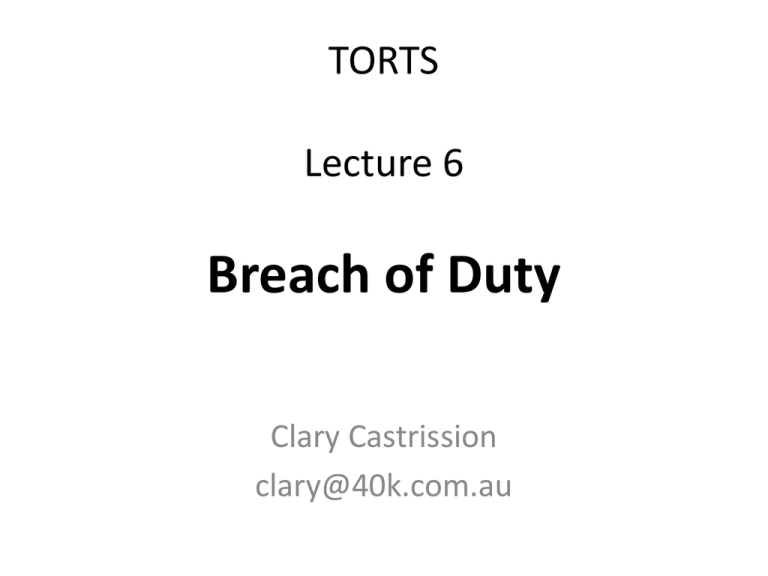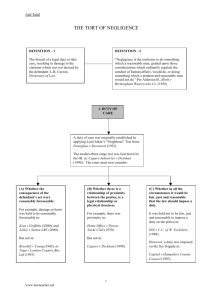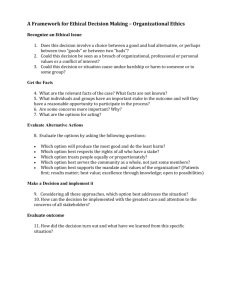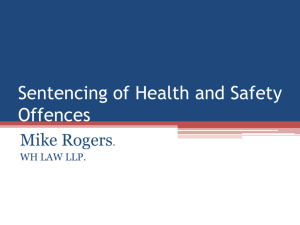Breach of Duty
advertisement

TORTS Lecture 6 Breach of Duty Clary Castrission clary@40k.com.au Wrapping up Breach of Duty • Standard of Care – What standard of care is owed? (Q of law) • Standard of care owed by the reasonable person in the circumstances • What would the reasonable person do in the D’s position • Duty breached – Did the D’s actions fail to meet that standard? • Was risk of injury to the P Reasonably foreseeable? • Degree of risk • Magnitude of harm • IF SO – Was the response of the d to this reasonable? • • • • Calculus of negligence (from s5B) AND where relevant, consider Reasonability of precautions Social utility Any relevant professional or statutory standards Breach of Duty from Shirt • If reasonable person in defendant’s position would have foreseen risk to the P, then: • “... it is then for the tribunal of fact to determine what a reasonable man would do by way of response to the risk. The perception of the reasonable man’s response calls for a consideration of the magnitude of the risk and the degree of the probability of its occurrence, along with the expense, difficulty and inconvenience of taking alleviating action and any other conflicting responsibilities which the defendant may have. It is only when these matters are balanced out that the tribunal of fact can confidently assert what is the standard of response to be ascribed to the reasonable man placed in the defendant’s position.” • Applied in Roads and Traffic Authority of NSW v Refrigerated Roadways Pty Limited [2009] NSWCA 263 (22 September 2009) • RTA v Dederer, Gummow J at [69]: “What Shirt requires is a contextual and balanced assessment of the reasonable response to a foreseeable risk.” Comparing DUTY to BREACH • Mason J in Wyong v Shirt at 47-48 • Wagon Mound (No. 2) per Lord Reid – A reasonable man would only neglect such a risk if he had some valid reason for doing so, eg, that it would involve considerable expense to eliminate the risk. He would weigh the risk against the difficulty of eliminating it ... Test for breach 1. Was the risk of injury to P reasonably foreseeable? DUTY 2. If so, was the response of the defendant to this risk reasonable? BREACH – Did the D meet the requisite standard of care? IF NOT, there has been a breach of duty Start with consideration of the risk 1. Degree of foreseeable risk – RTA v Dederer (2007) 238 ALR 761 • “It is only through the correct identification of the risk that one can assess what a reasonable response to that risk would be” (Gummow J at [59]) 2. Reasonableness of Defendant’s response to the risk Reasonable Person What would the reasonable person, in the defendant’s position (with the knowledge that they either had or ought to have had) have done in the circumstances out of which the harm arose? Was risk reasonably foreseeable? (s5B(1)(a)) • Romeo v Conservation Commission (NT) (1998) 192 CLR 431 – It is quite wrong to read past authority as requiring that any reasonably foreseeable risk, however remote, must in every case be guarded against (Kirby J at 480) • Check to see if: – Risk is not far-fetched or fanciful (or insignificant, under s5B) Risk not far-fetched or fanciful • The Wagon Mound (No. 2) [1967] 1 AC 617 • Wyong SC v Shirt (1980) 146 CLR 40 • Chapman v Hearse (1961) 106 CLR 112 “Calculus of Negligence” under 5B(2) • • • • Probability of harm occuring if care not taken Likely seriousness of harm Burden of taking precautions Social Utility Breach of Duty – Likelihood of Injury • Section 5B(2)(a) the probability that the harm would occur if care were not taken • Bolton v Stone [1951] AC 850 • RTA v Dederer (2007) 238 ALR 761 Breach of Duty – Seriousness of Harm • Section 5B(2)(b) the likely seriousness of the harm • Adelaide Chemical & Fertilizer Co. v Carlyle (1940) 64 CLR 514 • Paris v Stepney Borough Council [1951] AC 367 Breach of Duty – Cost of Avoiding Harm • Section 5B(2)(c) the burden of taking precautions to avoid the risk of harm • Caledonian Collieries Ltd v Speirs (1957) 97 CLR 202 Breach of Duty – Social Utility of the Act of the Defendant • Section 5B(2)(d) the social utility of the activity that creates the risk of harm. • Watt v Hertfordshire County Council Res Ipsa Loquitur • Elements: – Accident must raise presumption of negligence • Examples: Laurie v Raglan Building Co [1942] 1 KB 152, Chaproniere v Mason (1905) 21 TLR 644, Mahon v Osborne [1939] 2 KB 14 – Thing must be under D’s control – Actual cause of accident must not be known • Barkway v South Wales Transport [1950] AC 185 • Nominal Defendant v Haslbauer (1967) 117 CLR 448 • Effect Wrapping up Breach of Duty • Standard of Care – What standard of care is owed? (Q of law) • Standard of care owed by the reasonable person in the circumstances • What would the reasonable person do in the D’s position • Duty breached – Did the D’s actions fail to meet that standard? • Was risk of injury to the P Reasonably foreseeable? • Degree of risk • Magnitude of harm • IF SO – Was the response of the d to this reasonable? • • • • Calculus of negligence (from s5B) AND where relevant, consider Reasonability of precautions Social utility Any relevant professional or statutory standards Part 5 Liability of Public & Other Authorities • Sections 40 to 46 • Provides specific additional protection for public authorities including: - the Crown Government departments Local councils Other prescribed bodies Part 5 Liability of Public & Other Authorities • Section 42 sets out the principles to apply in determining whether a public or other authority has a duty of care or has breached a duty of care including: (a) the functions required to be exercised by the authority are limited by the financial and other resources that are reasonably available to the authority for the purpose of exercising those functions, (b) the general allocation of those resources by the authority is not open to challenge, (c) the functions required to be exercised by the authority are to be determined by reference to the broad range of its activities (and not merely by reference to the matter to which the proceedings relate), (d) the authority may rely on evidence of its compliance with the general procedures and applicable standards for the exercise of its functions as evidence of the proper exercise of its functions in the matter to which the proceedings relate. Part 5 Liability of Public & Other Authorities • Section 43: an act or omission by an authority does not constitute a breach of a statutory duty, unless the act or omission was so unreasonable in the circumstances that no authority having the functions in question could properly consider the act or omission to be a reasonable exercise of it function. Part 5 Liability of Public & Other Authorities • Section 44: Removes the liability of public authorities for failure to exercise a regulatory function if the authority could not have been compelled to exercise the function under proceedings instituted by the Plaintiff. S45- Roads Authorities • (1) A roads authority is not liable in proceedings for civil liability to which this Part applies for harm arising from a failure of the authority to carry out road work, or to consider carrying out road work, unless at the time of the alleged failure the authority had actual knowledge of the particular risk the materialisation of which resulted in the harm. • (2) Doesn’t create duty of care simply because the roads authority had actual knowledge of the risk. • (3) Carry out roadwork defined to include construction, installation, maintenance, inspection, repair Porter v. Lachlan Shire Council [2006] NSWCA 126 • Facts • CLA s3: In this section: "carry out road work" means carry out any activity in connection with the construction, erection, installation, maintenance, inspection, repair, removal or replacement of a road work within the meaning of the Roads Act 1993 . • Roads Act 1993 (dictionary) road work includes any kind of work, building or structure (such as a roadway, footway, bridge, tunnel, road-ferry, rest area, transitway station or service centre) that is constructed or installed on or in the vicinity of a road for the purpose of facilitating the use of the road as a road, the regulation of traffic on the road or the carriage of utility services across the road, but does not include a traffic control facility, and carry out road work includes carry out any activity in connection with the construction, erection, installation, maintenance, repair, removal or replacement of a road work. s45 - Porter v. Lachlan Shire Council • Hodgson JA (Beazley JA & Giles JA agreeing) • 34 In my opinion, this case does come within s45, on either of two bases. 35 First, where that part of a road used for pedestrian purposes has been altered by the installation of a footpath and a gutter, leaving what may be called a nature strip in between, it is in my opinion an unduly narrow view of what constitutes a road work to say that, while the made footpath is a road work and the gutter is a road work, the nature strip between them is neither a road work nor part of a road work. In my opinion the better view is that the whole of the area for pedestrian purposes, comprising the made footpath, the nature strip and the gutter, comprises a road work. • s45 - Porter v. Lachlan Shire Council • Hodgson JA (Beazley JA & Giles JA agreeing) • 36 Second, in any event, where there is a hole in that part of a road which is a nature strip within the area used for pedestrian purposes, it would be road work to fill and make good that hole. That view is not in my opinion precluded by the use of the words “constructed” and “installed” in the definition of road work in the Roads Act, which, unlike the relevant definition in s45 of the Civil Liability Act, is an inclusive definition and not an exhaustive definition. Once it is accepted that to fill and make good the hole would be road work, then the question would arise whether failure to do this would be failure to “carry out any activity in connection with the construction, erection, installation, maintenance, repair or replacement of a road work” within s45(3). In my opinion, it would be: although the words “construction” and “installation”, and the indefinite article “a” in front of “road work”, could be taken as inapt for the filling and making good of a hole, on balance I think it would be too narrow an approach to hold that the words do not extend to such activity. s45 - Porter v. Lachlan Shire Council • Hodgson JA (Beazley JA & Giles JA agreeing) – 37 On either basis, s45 applies: on the first basis, the allegation would be that the respondent failed to maintain a road work, and on the second basis, it would be that the respondent failed to construct or install a road work. s.45 Actual Knowledge: North Sydney Council –v- Roman [2007] NSWCA 27 • Facts • At trial s.45 North Sydney Council –v- Roman • Held, allowing the appeal, per Basten JA (Bryson JA agreeing): • 1. For the purposes of s.45 actual knowledge must be found in the mind of an officer within the council having delegated (or statutory) authority to carry out the necessary repairs. • 2. The evidence demonstrated that no Council officer at a decision-making level had “actual knowledge” of the particular pothole and therefore the appellant did not have such knowledge. Accordingly, the exception to s.45 was not engaged and the statutory immunity prevailed. Per McColl JA (dissenting) s.45 North Sydney Council-v- Roman • Held, allowing the appeal, per Basten JA (Bryson JA agreeing): • 1. For the purposes of s.45 actual knowledge must be found in the mind of an officer within the council having delegated (or statutory) authority to carry out the necessary repairs. • 2. The evidence demonstrated that no Council officer at a decision-making level had “actual knowledge” of the particular pothole and therefore the appellant did not have such knowledge. Accordingly, the exception to s.45 was not engaged and the statutory immunity prevailed. Per McColl JA (dissenting) Part 8: Good Samaritans • S56: – a "good samaritan" is a person who, in good faith and without expectation of payment or other reward, comes to the assistance of a person who is apparently injured or at risk of being injured. • s57 – (1) A good samaritan does not incur any personal civil liability in respect of any act or omission done or made by the good samaritan in an emergency when assisting a person who is apparently injured or at risk of being injured. Part 8: Good Samaritans (ss55-58) • S58: where liability not exempted: – Where good samaritan caused the injury in the first place, – The good samaritan was under the influence of drugs/alcohol AND failed to take reasonable care – The good samaritan was impersonating emergency service worker, policeman or pretending to have the skills to address the current injury Part 9: Volunteers (ss59-66) • Section 60: Defines community work to mean work that is not for private financial gain and that is done for a charitable, benevolent, philanthropic, sporting, educational or cultural purpose. It excludes community service orders imposed by a court. Parts 8 & 9 Good Samaritans & Volunteers • • • • • • • Section 61: No civil liability for a volunteer doing community work BUT does not extend to criminal acts (s62) Acts whilst intoxicated AND volunteer failing to exercise reasonable care and skill (s63) actions outside the scope of the charitable organisation or contrary to instructions (s64) where the volunteer is required by State law to be insured (s65) Or motor vehicle accidents (s66)






